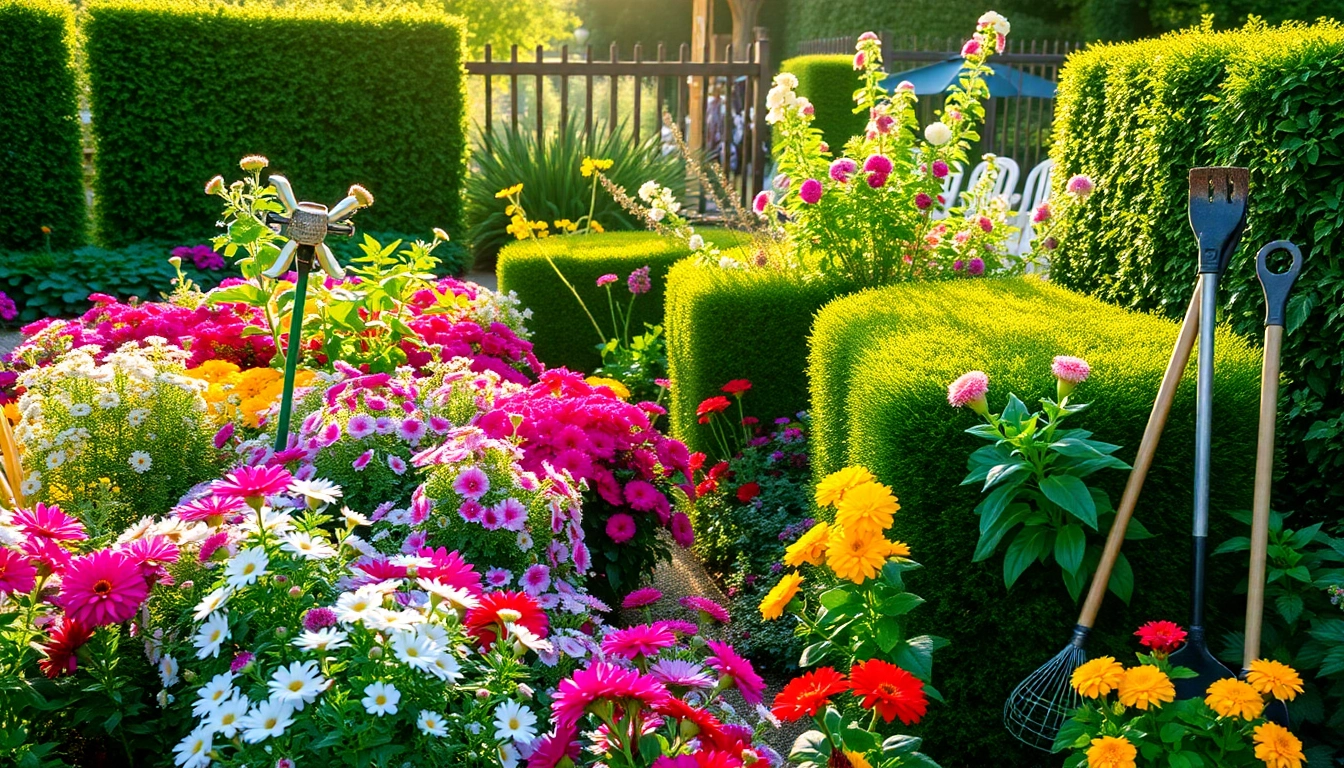Understanding the Basics of Garden Maintenance
Creating and maintaining a beautiful garden can be an incredibly fulfilling endeavor. To achieve a thriving green space, understanding the fundamentals of garden maintenance is crucial. Whether you are a novice gardener or someone looking to enhance your garden’s health, the right practices and knowledge can significantly impact your outdoor space.Garden maintenance services can simplify this process, offering expertise and professional help to ensure your plants flourish. In this guide, we will explore essential tools, soil health, and seasonal checklists that are integral to effective garden maintenance.
1. Essential Tools for Successful Garden Maintenance
Every successful gardener knows that having the right tools can make all the difference. Here are some essential tools you should consider investing in:
- Hand Trowel: Perfect for digging small holes, mixing soil, and transplanting seedlings.
- Pruning Shears: Ideal for shaping plants and removing dead or damaged branches.
- Garden Fork: Useful for turning soil, aerating, and mixing compost into your garden bed.
- Watering Can: Crucial for watering plants, especially delicate seedlings.
- Soil Moisture Meter: Helps you determine when and how much to water your plants.
- Rake: Essential for leveling soil and collecting leaves and debris.
These tools not only enhance the efficiency of your gardening tasks but also promote healthier plants by ensuring proper care and maintenance.
2. Importance of Soil Health in Your Garden
A thriving garden begins with healthy soil. Soil health affects plant growth, nutrient absorption, and water retention. Here are several key aspects to consider when assessing soil health:
- Soil Composition: Understanding the ratios of sand, silt, and clay in your soil can help you amend it effectively. Sandy soils drain quickly, while clay soils hold moisture but can become compacted.
- pH Level: Most plants prefer a pH range of 6.0 to 7.0. Regularly testing your soil can help you make necessary adjustments, such as adding lime to raise pH or sulfur to lower it.
- Organic Matter: Incorporating compost and other organic materials can improve soil structure, increase nutrient availability, and enhance water-holding capacity.
Investing time in understanding and improving your soil’s health is foundational for achieving a lush and productive garden.
3. Seasonal Maintenance Checklist for Homeowners
Garden maintenance is not a one-time activity; it varies with the seasons. Below is a seasonal checklist to guide your gardening activities throughout the year:
- Spring:
- Clean up garden beds, removing debris and weeds.
- Test soil and amend as necessary.
- Start planting seeds for annual flowers and vegetables.
- Summer:
- Regularly check for pests and diseases.
- Water deeply but less frequently to encourage deep root growth.
- Deadhead spent flowers to promote continuous blooming.
- Autumn:
- Harvest crops and prepare beds for winter.
- Add a layer of mulch to protect plants.
- Cut back perennials and remove dead plant material.
- Winter:
- Plan for your next gardening season.
- Inspect and maintain tools to prepare for spring.
- Consider creating a protective cover for vulnerable plants.
This checklist will help ensure that your garden remains healthy and vibrant throughout the changing seasons.
Common Challenges in Garden Maintenance
Even the most seasoned gardeners face common challenges that can impact their garden’s health. Understanding these issues and having effective strategies in place is vital for successful garden management.
1. Pest Control Strategies for Healthy Plants
Pests can wreak havoc in your garden, leading to stunted growth and damaged plants. Here are some natural pest control strategies:
- Companion Planting: Planting certain plants together can deter pests. For instance, marigolds are known to repel nematodes and other harmful insects.
- Neem Oil: Oil derived from the seeds of the neem tree can be used as a natural pesticide. It disrupts the life cycle of pests without harming beneficial insects.
- Handpicking: For small infestations, physically removing pests from plants can be effective, especially for larger ones like caterpillars.
Regular monitoring and early intervention are key components of maintaining a pest-free garden.
2. Dealing with Extreme Weather Conditions
Extreme weather can pose significant risks to your garden. Here are approaches to mitigate these challenges:
- Mulching: Applying a layer of organic mulch can regulate soil temperature, retain moisture during dry spells, and suppress weeds.
- Windbreaks: Planting hedges or installing fences can protect delicate plants from strong winds and storms.
- Drainage Solutions: Ensure proper drainage to prevent waterlogging during heavy rains, which can lead to root rot.
By preparing your garden for unpredictable weather, you’ll safeguard your plants and foster a resilient garden environment.
3. Preventing Weeds from Compromising Your Garden
Weeds are persistent and can quickly overtake your garden, competing with your plants for nutrients and water. Here are some effective prevention strategies:
- Regular Weeding: Hand-pulling weeds when they are young is most effective. Incorporate weeding into your weekly garden routine!
- Landscape Fabric: Installing landscape fabric in garden beds can suppress weed growth while allowing water and nutrients to reach your plants.
- Dense Planting: Growing plants closely together can inhibit weed growth by reducing space and light available for weeds to thrive.
With these techniques, you’ll keep weed pressure low and your plants thriving.
Best Practices for Sustainable Garden Care
As awareness of environmental issues grows, sustainable gardening practices have become more important than ever. Implementing eco-friendly strategies not only benefits your garden but also the planet.
1. Eco-Friendly Gardening Techniques
There are many ways to garden sustainably without sacrificing aesthetics or productivity:
- Composting: Recycle kitchen and garden waste into nutrient-rich compost to enrich your soil naturally.
- Native Plants: Selecting native plant species often requires less water and fertilizer, creating a self-sustaining ecosystem.
- Natural Pest Control: Utilizing beneficial insects, such as ladybugs and lacewings, can help manage pest populations without harmful chemicals.
Applying these sustainable practices helps protect our resources while creating a flourishing garden.
2. Efficient Watering Methods for Gardens
Water management is crucial for garden health, especially in areas experiencing drought. Here are efficient watering techniques:
- Drip Irrigation: This method delivers water directly to the plant’s roots, reducing evaporation and runoff.
- Rain Barrels: Collecting rainwater for use in your garden is a sustainable way to water without relying heavily on municipal resources.
- Soaker Hoses: These hoses allow water to seep slowly into the soil, providing deep watering directly to the root zone where it is needed most.
Implementing efficient watering techniques conserves water and promotes healthier plants by preventing over or under-watering.
3. Organic Fertilizers and When to Use Them
Using organic fertilizers can boost soil fertility and plant growth without the negative impacts of chemical fertilizers. Here’s how and when to use them:
- Compost: Well-aged compost can be applied in spring to promote vigorous growth by enriching soil with nutrients.
- Fish Emulsion: This liquid fertilizer is rich in nitrogen and is best used during the growing season when plants are developing foliage.
- Bone Meal: Add bone meal to the soil in early spring to support strong root development, especially for flowering plants.
Choosing the right organic fertilizers and knowing when to apply them are essential for nurturing your garden sustainably.
Advanced Garden Maintenance Techniques
For those looking to take their garden maintenance to the next level, advanced techniques can foster exceptional plant growth and garden aesthetics.
1. Companion Planting for Maximized Growth
Companion planting is the practice of pairing specific plants to enhance growth and deter pests. Here are some popular pairings:
- Tomatoes and Basil: This duo not only improves flavor but also repels pests like aphids and whiteflies.
- Carrots and Onions: When planted together, they help conceal each other from pests, improving overall yield.
- Cabbage and Dill: Dill promotes the growth of cabbage while repelling harmful pests.
By understanding plant relationships, you can create a harmonious garden ecosystem that supports overall health.
2. Pruning for Healthier Plants and Aesthetic Appeal
Pruning is essential for maintaining healthy plants and improving aesthetic appeal. Here’s how to do it effectively:
- Timing: Prune during dormancy for most trees and shrubs (late winter to early spring) to minimize stress.
- Tools: Ensure that you are using clean, sharp tools to make precise cuts and minimize the risk of injury to the plant.
- Techniques: Focus on removing dead or diseased branches, thinning out crowded areas for better air circulation, and shaping plants for desired aesthetics.
Strategic pruning promotes vigorous growth and enhances the beauty of your garden.
3. Implementing Mulching for Moisture Retention
Mulching plays a vital role in garden maintenance by retaining moisture, suppressing weeds, and improving soil quality. Here are the benefits of applying mulch:
- Water Conservation: A layer of mulch helps retain soil moisture, reducing the need for frequent watering.
- Weed Suppression: Mulch blocks sunlight, helping to prevent weed germination and growth.
- Soil Improvement: Organic mulch breaks down over time, adding nutrients to the soil and improving its structure.
Applying the right type of mulch and maintaining its thickness will provide long-lasting benefits to your garden.
Evaluating the Success of Your Garden Maintenance Service
To ensure your garden thrives, it’s important to evaluate maintenance services periodically. This ensures that you are meeting your gardening goals and objectives effectively.
1. Setting Performance Metrics for Growth
Establishing measurable performance metrics can help gauge the success of your gardening efforts. Consider the following:
- Plant Health: Monitor overall plant vitality, including growth rates, vigor, and presence of pests or disease.
- Yields: For vegetable gardens, track harvest quantities and quality to evaluate productivity.
- Soil Quality: Regular soil tests can indicate nutrient levels and pH balance, helping to assess improvements over time.
Regular evaluation of these metrics will help you adjust your maintenance strategies as needed.
2. How to Analyze Plant Health and Growth Rates
Analyzing plant health and growth rates involves systematic observation and recording data. Here’s how:
- Growth Measurements: Regularly measure plant heights, spread, and flowering times to track changes over time.
- Visual Inspections: Check for signs of stress such as wilting, discoloration, or stunted growth.
- Compare Data: Compare current observations with past data to assess overall garden progress and effectiveness of maintenance routines.
With diligent tracking, you can make informed decisions about managing your garden’s needs.
3. Adapting Your Maintenance Strategy Over Time
Gardens are dynamic systems that may require adjustments to maintenance strategies based on changing conditions and results. Here are some tips for adapting:
- Seasonal Adjustments: Be prepared to change your watering schedule, fertilization, and pest control strategies according to seasonal shifts.
- Embrace Feedback: Use observations from plant performance to make informed adjustments, such as altering plant types or locations based on what thrives best.
- Stay Informed: Keep abreast of gardening trends, new techniques, and potential challenges—adaptation is key in sustainable gardening.
By being flexible and responsive to your garden’s needs, you’ll create an ever-evolving landscape that remains healthy and vibrant.



